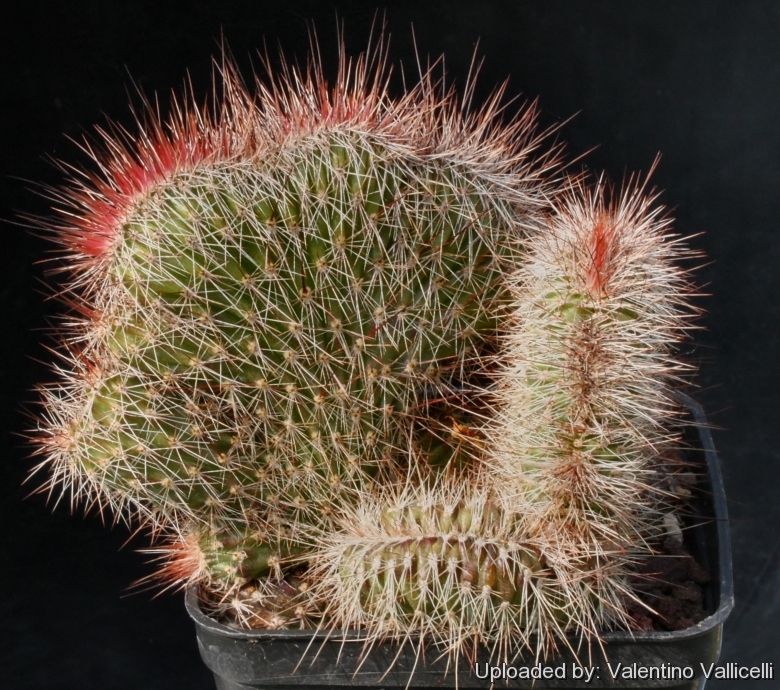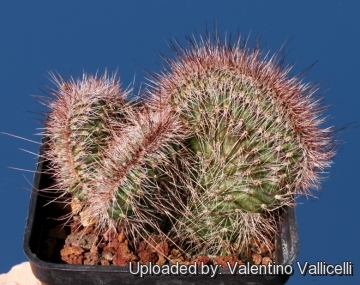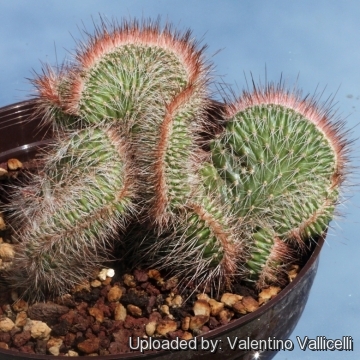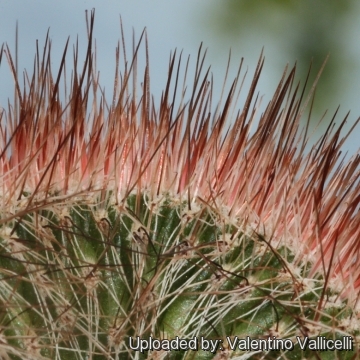Accepted Scientific Name: Peniocereus serpentinus f. cristata

Nyctocereus serpentinus f. cristata (Peniocereus serpentinus f. cristata) Photo by: Valentino Vallicelli
is a popular slender columnar cactus that with height will fall over and snake around. The crested form stay smaller and forms pronounced sculpture effects.
Origin and Habitat: Tropical areas of southern Mexico (México, Michoacán, Morelos, Oaxaca), but now largely spread around Mexico. The crested form is of garden origin (Nursery produced cultivar)
Synonyms:
See all synonyms of Peniocereus serpentinus
Common Names include:
ENGLISH: Queen Of The Night (Crested), Crested Night-blooming Cereus, Crested Snake Cactus
SPANISH (Español): Reina de la Noche, Junco Espinoso (Mexico)
Description: The typical Nyctocereus serpentinusSN|7251]]SN|7251]] is a fast-growing slender, shrubby columnar cacti from that grows often in groups, erect at first sometimes climbing then leaning and sprawling all over and best tied to something so it wont fall and grow decumbent. It would be good for hanging baskets.
Stem: Slender, snake-like, dark coloured, cylindrical, 3-6 meters long, 2,5-5 cm in diameter.
Roots: Large tuberose
Ribs: 10-17 obtuse.
Areoles: Whitish white wool
Spines: 9 to 14 needle-like spines, whitish to reddish when young, with darker tips, 10-30mm long.
Flowers: When old enough it bears large, nocturnal flowers, they are funnelform, white with pinkish outside segments, 15 to 20cm long (15 cm in diameter), pericarpel and flowers with bristles. The flowers are very fragrant, like gardenias.
Fruits: 4-6 cm long, red, egg-shaped, edible, spiny, with spines that fall when it is ripe.
Seeds: Black 5 mm Long.
Remarks: The crested form are cultivated for their beautiful stem with long bristly dark brown-red spine and pronounced sculpture effects. These plants produce monstrous crests, and crests occasionally produce normal shoots.
Subspecies, varieties, forms and cultivars of plants belonging to the Peniocereus serpentinus group
 Peniocereus serpentinus (Lag. & Rodr.) N.P.Taylor: It is fast-growing slender, shrubby columnar cactus that grows often in groups, erect at first sometimes climbing then leaning and sprawling all over and best tied to something so it wont fall and grow decumbent.
Peniocereus serpentinus (Lag. & Rodr.) N.P.Taylor: It is fast-growing slender, shrubby columnar cactus that grows often in groups, erect at first sometimes climbing then leaning and sprawling all over and best tied to something so it wont fall and grow decumbent. Peniocereus serpentinus f. cristata: The crested form stay smaller and forms pronounced sculpture effects.
Peniocereus serpentinus f. cristata: The crested form stay smaller and forms pronounced sculpture effects.
 Nyctocereus serpentinus f. cristata (Peniocereus serpentinus f. cristata) Photo by: Valentino Vallicelli
Nyctocereus serpentinus f. cristata (Peniocereus serpentinus f. cristata) Photo by: Valentino Vallicelli Nyctocereus serpentinus f. cristata (Peniocereus serpentinus f. cristata) Photo by: Valentino Vallicelli
Nyctocereus serpentinus f. cristata (Peniocereus serpentinus f. cristata) Photo by: Valentino Vallicelli Nyctocereus serpentinus f. cristata (Peniocereus serpentinus f. cristata) Photo by: Cactus Art
Nyctocereus serpentinus f. cristata (Peniocereus serpentinus f. cristata) Photo by: Cactus Art Nyctocereus serpentinus f. cristata (Peniocereus serpentinus f. cristata) Photo by: Valentino Vallicelli
Nyctocereus serpentinus f. cristata (Peniocereus serpentinus f. cristata) Photo by: Valentino Vallicelli Nyctocereus serpentinus f. cristata (Peniocereus serpentinus f. cristata) Photo by: Valentino Vallicelli
Nyctocereus serpentinus f. cristata (Peniocereus serpentinus f. cristata) Photo by: Valentino VallicelliSend a photo of this plant.The gallery now contains thousands of pictures, however it is possible to do even more. We are, of course, seeking photos of species not yet shown in the gallery but not only that, we are also looking for better pictures than those already present.
Read More... Cultivation and Propagation: Although regarded as a choice and difficult plant is not too difficult in a greenhouse, although grows quite slowly. It is sometime seen as a grafted plant but grows very well on its own roots too.
Soil: Use mineral well permeable mineral soil with little organic matter (peat, humus).
Exposure: They need a good amount of light shade to full sun this help to keep the plants healthy, although slow growth.
Watering: Water sparingly from March till October (weekly during summertime, if the weather is sunny enough) , with a little fertilizer added. Less or no water during cold winter months, or when night temperatures remain below 10° to prevent root loss. It is sensitive to overwatering (rot prone).
Fertilization: Feeding may not be necessary at all if the compost is fresh then, feed in summer only if the plant hasn't been repotted recently. Do not feed the plants from September onwards as this can cause lush growth which can be fatal during the darker cold months.
Hardiness: The plants will stand but little cold and require a minimum winter temperature of about 10° C. (but can resist for short period to 0° C).
Crested growth: Unlike 'monstrose' varieties of plants, where the variation from normal growth is due to genetic mutation, crested growth can occur on normal plants. Sometimes it's due to variances in light intensity, or damage, but generally the causes are unknown. A crested plant may have some areas growing normally, and a cresting plant that looks like a brain, may revert to normal growth for no apparent reason. If you have any of the crested part left you need to remove the normal growth and leave the crested part behind this will need to be done regularly. Propagation: Grafting or cuttings. Plants are usually grafted onto column-shaped cacti but proved to be able to produce their own roots if degrafted. Cuttings will take root in a minimum temperature of 20° C (but better in hot weather). Cuttings of healthy shoots can be taken in the spring and summer. Cut the stem with a sharp, sterile knife, leave the cutting in a warm, dry place for a week or weeks (depending on how thick the cutting is) until a callus forms over the wound. Once the callus forms, the cutting may be inserted in a container filled with firmed cactus potting mix topped with a surface layer of coarse grit. They should be placed in the coarse grit only; this prevents the cut end from becoming too wet and allows the roots to penetrate the rich compost underneath. The cuttings should root in 2 to 6 weeks. Large crested piece must be placed on the soil surface without burying the plant base down in the soil.
















